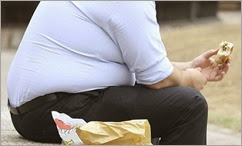Provided by The Guardian
Robin McKie, Science Editor
The Observer, Saturday 14 December 2013 07.17 ES
Few people are aware that there is a clear link between obesity and cirrhosis. Photograph: Dominic Lipinski/PA
Doctor Jude Oben had grim news for a patient last week. The liver expert told the 60-year-old man that he had cirrhosis – for the second time in his life.
Only four years ago Oben's patient had required a liver transplant after his first bout of cirrhosis, a condition he had contracted because he was obese. "Unfortunately my patient continued to overeat and remained obese," said Oben, a hepatologist based at the Royal Free and St Thomas' hospitals in London. "As a result, he contracted cirrhosis again. Sadly, I had to tell him that this time it was very unlikely he would be given another liver."
Oben's patient is one of a "tidal wave" of cases of cirrhosis, triggered by obesity, that threatens to sweep through hospitals across the UK. "People might be aware that there are metabolic disorders such as diabetes and high blood pressure associated with obesity, but very few know about the connection with cirrhosis. However, there is a very clear link. Obesity can trigger cirrhosis."
Oben, who recently launched the charity Obesity Action Campaign to help in the battle against the spread of the condition, said that 10 years ago he saw only an occasional case of obesity-related cirrhosis in his clinic. Today he has dozens of cases of the illness, which occurs when irreversible scarring causes a person's liver to deteriorate. In the past, excess alcohol consumption and hepatitis infections have been the main causes of cirrhosis in Britain. Now a third cause – obesity – has triggered a major increase in cases of liver disease in the UK.
The average age of death from liver disease is 59, compared with 82-84 for heart and lung disease and strokes, for example. It is the fifth largest cause of death in the UK, and in the past 10 years there has been a fivefold increase in cirrhosis for those aged between 35 and 55. Oben predicts that these figures are only going to get worse as obesity levels rise.
"About a third of the UK population is now obese, while one government estimate recently suggested that this figure will rise to 50% by 2050," said Oben. "Frankly, I think we will have reached that level long before then, and when we do that we will find that cirrhosis case numbers have increased steeply."
Nor will cirrhosis cases be the only ones to follow in the wake of Britain's increasing obesity levels. Cancers of the oesophagus, liver, pancreas and colon are linked to obesity; cases of these are increasing and are expected to continue to rise.
"Frankly, we are reaching US levels of obesity," said Oben. "I went to work in the US in 2001 and was stunned by the numbers of obese people that came into clinics. When I came back to Britain a few years later, I discovered – to my horror – that we are catching up."
As to the causes of this expected tidal wave of obesity-linked illness, scientists point to the increasing abundance of calorie-dense foods and a decrease in numbers of people taking regular exercise. In addition, Oben's own research has indicated that obese mothers may pass on a propensity for their offspring to become obese.
"It is another worrying factor," he said. "Obesity is a very difficult condition to treat medically."
WATCH THAT WAIST
According to Jude Oben – who also works as a researcher at University College London – the key indication that a person is dangerously obese is not provided by their weight or by their body mass index, which is calculated by combining a person's height and weight. "You can have a high body mass index but be quite fit," he said. "In fact, the most reliable factor is simply your waist circumference."
FOR WOMEN
With waist circumferences of under 31 inches (79cm), there should be no major health problems. For those between 31 inches and 35 inches (89cm), the outlook is worrying. For those over 37 inches (94cm), the prognosis is alarming.
FOR MEN
The danger zone begins for those whose waists are greater than 37 inches, while those over 40 inches (102cm) face prospects that Oben also describes as alarming.
Obesity Action Campaign www.obesityac.org

No comments:
Post a Comment